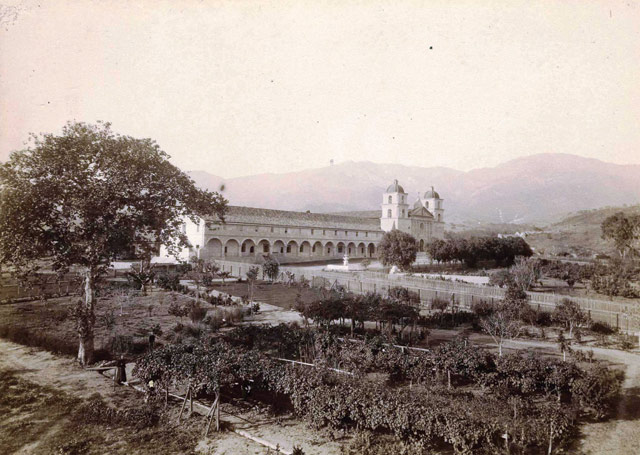S.B. Wine Industry
Viticulture Growth in Santa Barbara

Viticulture has been one of the most dramatic “growth” industries in Santa Barbara County for the last 30 years. In 1970, less than 200 acres were planted in grapes. By the mid 1990s, this figure had reached some 10,000 acres. This most dynamic of industries had its beginnings with the arrival of the Spanish in the 1780s.
The Spanish introduced winemaking to the New World shortly after Hernán Cortés completed the conquest of the Aztecs in 1521. Although there are several varieties of grapes native to the Americas, none were found suitable for the production of wine. So the Spanish imported vitis vinifera shoots from Europe to begin an infant wine industry. The motivation behind this effort was largely religious; wine is a key ingredient in the holy sacrament in Roman Catholicism.
When the Spanish began to move into Alta California in the late 1700s, they brought vitis vinifera with them. Exactly when this occurred remains unclear; it was perhaps as early as the 1769 Gaspar de Portolá expedition, although the first mention of vineyards in Alta California is a reference to Mission San Juan Capistrano in 1779.
Whatever the exact date, it is clear that the focus of wine production in Spanish California was the mission system. All 21 missions, including Santa Barbara, La Purísima, and Santa Inés, planted vineyards. The largest vineyard in the system was at Mission San Gabriel, which had some 164,000 vines in the early 1840s. The second largest producer among the missions was Santa Barbara, with around 12,000 vines producing about 6,000 gallons of wine.
The grape that was cultivated during this period was known as the mission grape. The fruit was high in sugar and low in acid, producing a very sweet wine. The missions also produced aguardiente, a form of brandy. The quality of these California products varied greatly and was not to everyone’s taste. One visitor, George Simpson, had some very unkind things to say about California wine on the occasion of his visit in 1842, although he did praise the product from the vineyard of Mission Santa Barbara. Another commentator was quite complementary about the aguardiente produced here.
Production techniques varied. In one, hides were placed upon a piece of sloping ground. As Chumash laborers stomped on the grapes, the juice running off the lower end of the hides was caught in jars and transferred to wooden casks to ferment. For smaller batches, grapes were placed in a cowhide bag, which was compressed. The juice remained in this bag to ferment and then was consumed fairly soon after.
Besides a small planting at the mission itself, Mission Santa Barbara had three vineyards, the largest of which was near San José Creek in the Goleta Valley. What remains of the winery there is a Santa Barbara County Landmark. The presidio had its own small vineyard in the area of present-day Carrillo and De la Vina streets. The name of the latter was taken from this vineyard.
In the mid 1800s, as the mission system crumbled, private production became ever more important. Many of the large ranchos had vineyards, including a number in the Santa Ynez Valley. On this side of the mountains, Nicholas Den maintained an impressive vineyard at Rancho Dos Pueblos. According to the 1860 federal census, Santa Barbara County, which also included present-day Ventura County, ranked third in wine production in the state—more than 10,000 gallons. This was dwarfed by production in the leading county, Los Angeles, which totaled more than 150,000 gallons.
As the 20th century dawned, Santa Barbara County was home to a small, but not insignificant, wine industry. Major wine production in the state had shifted to northern California, and it would not be until the 1960s that a few entrepreneurs would pioneer the renaissance of viticulture in the county.
As of 2009, the wine industry in Santa Barbara County generated some $360 million and produced more than a million cases of wine yearly. Viticulture is a major component of Santa Barbara County’s economy, just as it was more than 150 years ago.



